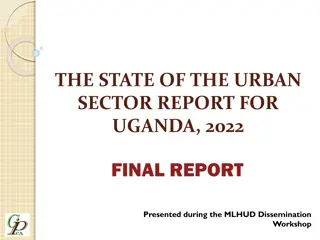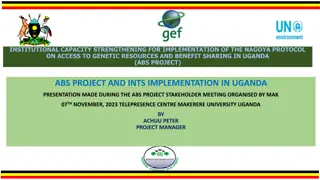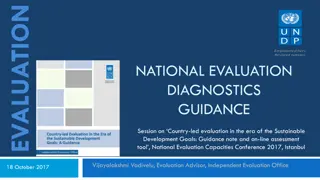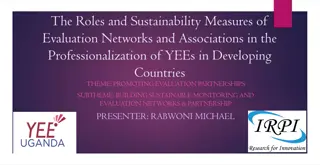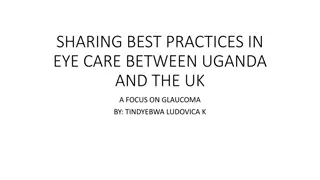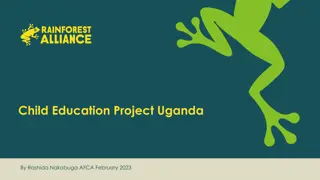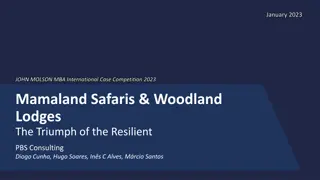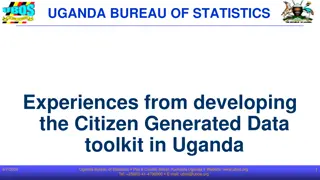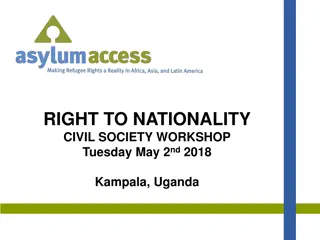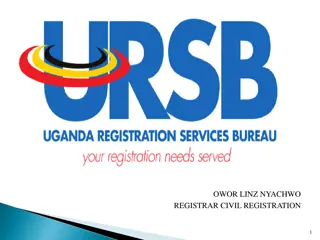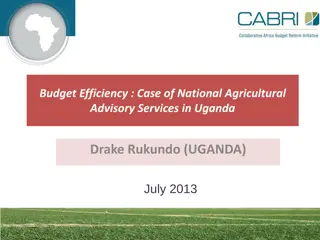Strengthening Uganda's National M&E System through UEA Evaluation Strategies
Uganda Evaluation Association (UEA) plays a key role in enhancing the quality of the National Monitoring and Evaluation (M&E) System. The SWOT analysis reveals UEA's strengths, weaknesses, opportunities, and threats, while also evaluating the National M&E System in Uganda. The UEA's strategies for strengthening the M&E system, future plans, comparison with other National Evaluation Societies, and information sharing are highlighted. Overall, UEA aims to leverage its strengths, address weaknesses, capitalize on opportunities, and mitigate threats to advance the M&E landscape in Uganda.
Download Presentation

Please find below an Image/Link to download the presentation.
The content on the website is provided AS IS for your information and personal use only. It may not be sold, licensed, or shared on other websites without obtaining consent from the author.If you encounter any issues during the download, it is possible that the publisher has removed the file from their server.
You are allowed to download the files provided on this website for personal or commercial use, subject to the condition that they are used lawfully. All files are the property of their respective owners.
The content on the website is provided AS IS for your information and personal use only. It may not be sold, licensed, or shared on other websites without obtaining consent from the author.
E N D
Presentation Transcript
The role of Uganda Evaluation Association (UEA) in strengthening the quality of the National M&E System By Isaac Senyonjo
Outline a) The Strength, Weakness, Opportunities and Threats (SWOT) Analysis of UEA b) The Strength, Weakness, Opportunities and Threats (SWOT) Analysis of the National M&E system in Uganda c) The UEA strategies to strengthen the M& E system and the M&E society, the short term & long term future plans d) A Comparison of the UEA and other National evaluation societies (NES) that attended the seminar in the context of their Startup and official recognition; Sources of funding, Human resources, Sectoral and membership composition e) Information sharing
The SWOT Analysis of the UEA Strength of the UEA 1) Established secretariat 2) Active executive committee 3) Availability of Evaluation standards 4) Forum for members Professional Development (NEK) 5) Membership subscription
Weakness of the UEA 1) Inadequate tangible benefits to members 2) Inadequate staff 3) Limited funding sources 4) Failure to operationalize evaluation standards 5) Limited visibility of UEA 6) Absence of board of Trustees to provide strategic direction to the executive
Opportunities to the UEA 1) Legally registered 2) Strong reputation among partners & worldwide 3) Fairly diverse membership from different sectors 4) Spirit of voluntarism 5) Strong support from Government (OPM)
Threats of the UEA 1) Limited involvement in influencing government policies 2) Missing working relationship with like- minded associations 3) Dependence on member s voluntarism 4) Attrition/Transint of members
The SWOT Analysis of the National M&E system in Uganda The Diagnosis was based on the checklist, developed from documents regarding the National M&E system in Uganda, which include: The National M&E policy and Plan, Documents illustrating the use of M&E outputs like the performance reports & a face to face discussion that was made with some officers at the OPM.
The checklist focused on the following topics i. The M&E Policy ii. The Quality of Indicators, Data (collection) & Methodology iii. Organisation Structure, its linkage & capacity iv. Participation of Non-Government actors v. M&E outputs; Quality and Use
Strength in the National M&E system 1) Existence of a comprehensive M&E policy & plan for MDAs 2) A functional linkage between the M&E coordinating entity & UBOS 3) An established system (PBS) of comparing the level of achievements against targets in MDAs 4) A culture of developing evaluation information products 5) Presence of oversight bodies that includes non state actors like Parliament, CSOs, DPs, etc.
Weaknesses the National M&E system 1) Uncoordinated evaluation sector methodologies i.e. each sector uses its own methodologies 2) Limited M&E capacity among public sector officers 3) Inadequate budget allocation for M&E activities 4) Absence of an integrated M&E capacity building plan 5) Weak mechanism to enforce evaluation recommendations among MDAs 6) Although the policy is clear on the role of parliament on M&E, their participation is limited
Opportunities in the National M&E system 1) Strong good will of Donors to finance M&E, mainly 3ie, DFID & UNDP 2) Emerging results based methodologies 3) Evidence driven policy making wave/trend globally 4) Increasing number of M&E training institutions 5) A CSO equipped with M&E skills and experience 6) GAPR structure to compel MDAs to give feedback on utilization of Evaluation recommendations
Threats of the National M&E system 1) Donor funding for evaluation is unpredictable in the sense that recipient sectors have no control over it 2) Parallel development of sector M&E framework 3) Complex design of the system (PBS) that is supposed to compare level of achievement against targets 4) Limited interest of parliament in M&E 5) Limited resources to operationalize the approved M&E structure in public sector
The UEA Strategies to strengthen the M&E system & UEA, short term & Long term strategies UEA strategies a) Conduct a stakeholder mapping b) Review the UEA strategic plan c) Standardize membership criteria with that of other NES d) Operationalize the resource mobilization strategy e) Up date members data base to capture expertise f) Strengthen traineeship/internship and mentorship programs for YEEs
Strengthen the M&E system Increase Supply of M&E 1) Strengthen stakeholders capacity 2) Network with academic institutions & professional bodies 3) Develop clear guidelines for engagement with the Donors and other Funding Agencies Increasing Use 1) Develop an M&E communication strategy 2) Widely share GAPR recommendations for the data to reach all parts of the country 3) Further institutionalize M&E in all governance structures 4) Further strengthen an incentives system for integration of evaluation findings in programs 5) Further synchronisation of data collection and harmonisation with the UBOS in all sectors
Strengthen the M&E system Increasing Demand 1) Strengthen citizen engagements (barazas) 2) Build capacity of outside government M&E actors (MPs, CSO, donors, media) 3) Promote structured engagement with CSO and government to participate in M&E events 4) Strengthen annual sector reviews 5) Further integrate M&E in all Gov`t programs
Future plans Short term a) Disseminate the SWOT to OPM & UEA members b) Partner up with academic Institutions for evaluation journal Medium term 1) Pursue a formal relationship with Gov`t (MOU, legal instrument) 2) Introduce a professional certification of members 3) Conduct national talks thru Webinars 4) Harmonisation of working relationships between the Auditor Generals Office, OPM, UBOS and UEA, so as to avoid inherent confusions and duplications of responsibilities.
COMPARISON OF UEA WITH OTHER NES A Comparison of the UEA and other National evaluation societies (NES) that attended the seminar in the context of their Startup and official recognition; Human resources, Sectoral and membership composition Sources of funding,
Bukina Faso and UEA were the oldest NES that attended the workshop; The UEA started in the year 2001 and officially recognition in 2002 & that of Bukina Faso started in the year 1997 & recognized in the year 2006
Figure 2: Sources of funding for NES 100 90 80 70 60 university private sector 50 donor agencies government 40 membership fee 30 20 10 0 Bolivia Cambodia DRC ecuador ethiopia Palestine Kenya senegal tanzania uganda vietnam
Figure 2: Human resources in NES 18 16 14 12 10 8 6 active volunteers part time staff 4 full time staff 2 0
Percentage Proportion of Board membership to the UEA Year 2017 Proportion Number of board members in the year 2017 7 Proportion (%) of board members from government 42. 9 14.2 14.2 Proportion (%) of board members from Parliament Proportion (%) of board members from civil society Proportion (%) of board members from donors 0 Proportion (%) of board members from academia 28.6 14.2 Proportion (%) of board members from private sector ( e.g. consultants) Overall Sectoral diversity board members(N sectors present among 0
UEA MEMBERS Number of official members in the year 2017 120 Number of informal members in the year 2017 461 Proportion (%) from government 24.3 Proportion (%) from Parliament 0.01 Proportion (%) from civil society 16.7 Proportion (%) from donors 0 Proportion (%) from academia 3.6 Proportion (%) from private sector ( e.g. consultants) 10.7 Overall sectoral diversity members (N sectors present among members) 44.8 Number of participants in the last general assembly/ UEA meeting/ Open to all members 89
COMPARISON with OTHER NES Bolivia Cambodia DRC ecuador ethiopia Palestine Kenya senegal tanzania uganda vietnam Number of official members 25 35 0 50 >100 23 100 359 300 120 0 Number of informal members 120 61 0 50 >100 17 200 62 150 461 0 Number of participants in the last G/ meeting 16 0 0 30 57 9 25 34 0 89 0 Board members 8 0 5 5 8 9 8 0 6 7 0
Sectoral membership of Board 100% 90% 80% 70% 60% 50% 40% 30% 20% 10% 0% Bolivia Cambodia DRC ecuador ethiopia Palestine Kenya senegal tanzania uganda vietnam Gov Parl civ soc donors academia private What sectors are missing? What sectors are over represented on the board? Is this a problem? Does this kind of unbalanced representation pose challenges in the association? If yes what are the likely challenges? There four, there are some Strengths from each sector, possible good practices and useful information we could share, to take the association to another level?
INFORMATION SHARING AMONG UEA MEMBERS We look at the Network of Key members ( based on the name generated by members of the evaluation) The focus was on the M&E related information sharing among the NES members Size of the nodes: the bigger the node, the more information they send to other members
Information sharing networks cont a) Do we Intensively share information? b) Who s central in information sending? Many/ few? Is it a vulnerable network ( if a key actor is no longer there, does the network fall apart?) c) Is it efficient? Or are there many redundant ties? d) Who are central in sending information? May/ Few? Are all sectors reached?
Information sharing networks cont Sector perspective: a) who is central in the network? b) Are there biases to wards one or two sectors? c) Which sectors are poorly represented? Are there ways to get other sectors more in the centre of the network? d) Is there mostly inter- sectoral communication i.e. gov communicating to government actors? Civil society to civil society? Is this problematic? e) Is the sectoral network vulnerable? Are certain sectors cut off if a certain key actor is no longer in the network?
Information sharing network cont.. Recommendations a) There is need to: 1. Identify accountability champions in all crucial sectors within UEA. 2. Identified core groups to identify the sectors that are missing
Activities Face to Face and Online activities Does our UEA perform well in terms of: a) Face to face activities? or b) Online activities? If not, is this a deliberate strategy? Do we focus more on one mode of interaction (face to face/ online)? What should we do more in the future?
Face to Face activities Uganda Face to face Number of face to face meetings per year open to all members 13 Number of face to face meetings of board members 12 Number of workshops/ seminar/ learning activities per year 14 Number of networking activities per year 12 Number of awareness raising activities per year 0
Online activities Online NES activities 10 9 8 7 6 online interaction soc media: twitter 5 soc media: FB list 4 website 3 2 1 0 Bolivia Cambodia DRC ecuador ethiopia Palestine Kenya Senegal Tanzania Uganda Vietnam




